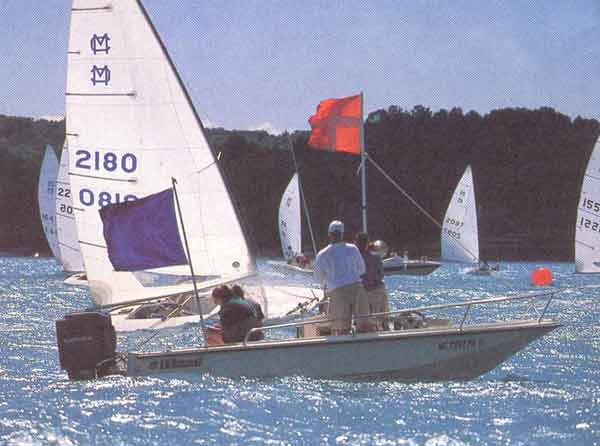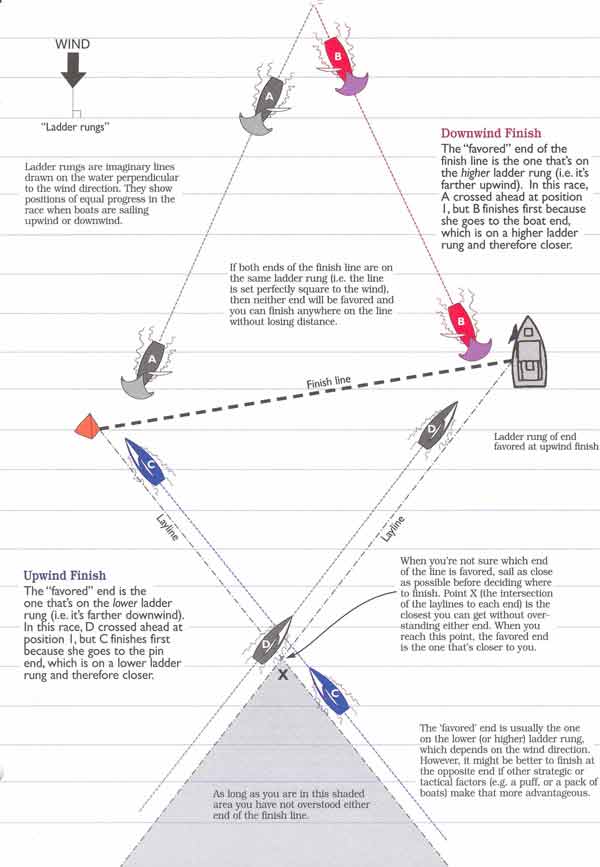How to Pick the ‘Favored’ End
by David Dellenbaugh
Race committees usually try to set their finish lines square to the wind
direction, but windshifts and other factors often skew the line and favor one
end. It’s not uncommon for this favored end to be two or more boatlengths
closer, and when you’re trying to gain every inch to beat your competition, this
can make a huge difference.
Theoretically, a good way to understand the orientation of any finish line is
by visualizing “ladder rungs,” or imaginary lines drawn on the water
perpendicular to the wind direction. At an upwind finish, the favored end is the
one on the lower ladder rung (since you are climbing up the ladder and you’ll
get to this one first). At a downwind finish, the favored end is on the higher
ladder rung.
| One way to determine the
favored end of the finishing line is to look at the angle of boats as they
cross the line. Unless the line is square, one tack (port or starboard) will
be more perpendicular to the line.
At an upwind finish, you should finish at the
end that is on your leeward side when you are sailing the more perpendicular
tack. In this photo, for example, you can see the scow #2180 is sailing
almost straight across the line on port tack, so the near end is favored by
a lot.
There are a couple of corollaries to this
rule of thumb. First, if one tack is more perpendicular to the line, the
other tack is more parallel to it. Avoid sailing on this parallel tack any
longer than needed to get to the line. Second, at a downwind finish, the
favored end is the one on your windward side when you are sailing the more
perpendicular jibe.
JH Peterson photo |
 |
In practice, however, you can’t see ladder rungs, so it’s not always easy to
identify the favored end of the finish line. Here are a few ideas:
• Watch where other boats go. This is a very good guide but, of course, it
won’t work unless you have another fleet, or some boats from your own fleet,
ahead of you. Keep a close eye on where these boats finish. If almost every one
goes to the pin, for example, there’s a good chance that end is favored. Pay
special attention to where the better sailors finish and which end is chosen by
boats that finish very close together.
• Remember the starting line. Sometimes the race committee leaves the
starting line untouched and uses it for the finish line. This makes your job a
little easier. If you are finishing downwind, go to the end that was favored at
the start. For an upwind finish, head for the end that wasn’t favored. Of
course, you must consider windshifts that have occurred since the start and the
possibility that the RC may have moved the line when you weren’t looking!
• Check out the finish line during the race. Often the race committee sets
the finish line while you are in the middle of your race. If you happen to sail
by the finish on a different leg, take a good look. Which end looks better?
If you have a hard time judging the favored end of a finish line, think of it as
a starting line. Often it’s easier to figure out the favored end for starting -
then use that info for finishing.
Another method I use is to look for the tack (port or starboard) that is more
perpendicular to the finish line. If boats sail more directly across the line on
starboard tack, for example, then the port end of the line is favored, and vice
versa.
• Wait until you are closer. If you can’t use any of the above techniques,
don’t make a decision about the favored end until you get a better look at the
finish line. You can postpone this decision as long as you don’t overstand
either end of the finish line (you’re OK if you stay in the shaded area on the
next page). If you go past the layline to either end and that end turns out to
be favored, you’ll lose distance.
Your last chance to make a decision is when you get to the intersection of both
laylines (X). At this point, the end that is closer to you is also favored, so
keep going or tack toward that end. This technique works with finishes that are
downwind as well as upwind.

Dave publishes the newsletter Speed & Smarts. For a subscription call:
800-356-2200 or go to:
www.speedandsmarts.com

